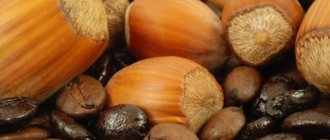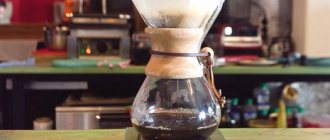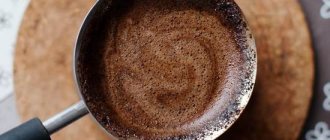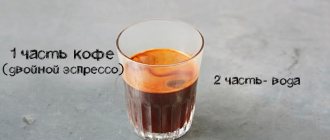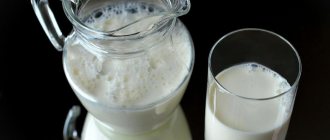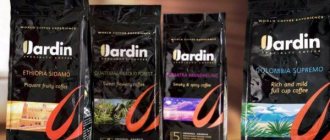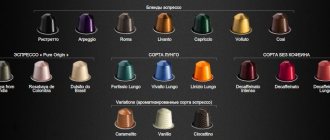What is the difference between an Arabic invigorating drink?
In eastern countries, coffee with a pleasant aroma is poured into small cups. It is not prepared using a coffee machine. The ground cardamom seeds turn into dust, which clogs the filter of the device.
The main distinguishing feature of Arabic coffee is its rich, bitter taste. It is prepared with the addition of spices.
To ensure a rich taste of the drink, several varieties of coffee beans are used. Residents of European countries do not know exactly what raw materials are used to cook it. It is only known that Arabs often use Arabica and Robusta to prepare it.
For proper cooking, use cold water. It turns into steam, which colors the grains yellowish.
You cannot turn coffee beans into dust by hand. For this purpose, a special grinding device is used - an electric mill.
The combination of Robusta and Arabica makes this drink delicious. The fruits of the first type of tree give the drink strength and bitterness, while the fruits of the second type give it subtle and delicate notes.
According to Arab gourmets, to get delicious coffee, you need to brew it using different types of beans. It is advisable that they be taken from different plantations.
One of the favorite Arabic coffee varieties is Mocha, grown in the city of Moho. These grains are easy to grind and have a pleasant taste and aroma. Drinking a drink made from mocha fruits invigorates the body. To feel a surge of strength and energy, just drink 1 small cup.
The main manufacturing nuances
To make coffee in Arabic, a Turka or cezve (a copper vessel with a long handle) is suitable. Ground grains (2 teaspoons) are poured into a bowl and filled with cool water (approximately 80 ml). Some people prefer to bring the drink to a boil. Others wait for the “moment of a thousand streams” - this is the time when the water is saturated with air bubbles before boiling.
Sweet lovers can use sugar 1:2 to ground coffee. It is placed in a cezve and put on fire. The grains should melt completely, turning into a thick syrup. This will give the drink a caramel flavor. After which the coffee is prepared according to the traditional recipe. You can add herbs and spices to the drink.
The Arabs have another popular coffee recipe. Per serving, put two spoons of coffee and one of sugar into the cezve and mix thoroughly. Add 50 ml of water and cook until boiling. As the coffee foam begins to rise, the cezve is removed from the heat and the foam is skimmed off. The function is repeated three times in order to extract an indescribable smell and the best taste properties from the grinding. The drink comes out sweet and strong.
Raw, cool water should be used. The vessel for making coffee must have a thick bottom and walls. The drink is brewed over low heat. Ground Arabic coffee should be stored in a cool, unlit place (maybe in the refrigerator) in an airtight container.
Arabic coffee.
Arabic coffee is an oriental drink for gourmets, which is slowly drunk in hot, small sips in a cozy, quiet atmosphere to the sounds of measured, pleasant music. Real Arabic coffee cannot be prepared in a coffee machine. For him, the grains are crushed so finely that they practically turn into dust. And such small particles will clog the espresso machine filter. The grains can only be ground into a powder mixture using a special manual or electronic mill. The resulting drink is bitterer and has a richer taste than Turkish coffee. Very often coffee contains cardamom and various spices.
To make Arabic coffee, a special mixture of coffee beans is used, which is kept secret. Therefore, many believe that the best varieties of beans are Arabica and Robusta. But this is the name of coffee trees, and their fruits differ in caffeine content, taste and smell. Arabica is narrower and warmer, while Robusta is strong and bitter. Therefore, when choosing grains, you can only rely on your own taste preferences. The mocha variety is perfect for making. This is a type of Arabic coffee from the town of Moho with high-quality beans, an indescribable taste and smell.
- Calorie content per 100 g - 41 kcal.
- Number of servings - 1
- Production time - 5-7 minutes
Ingredients:
- Ground coffee beans - 1 tsp.
- Sugar - 1 tsp. or to taste
- Drinking water – 75 ml
Rules for brewing Arabic coffee
The main requirement for cooking is a good mood and a pleasant atmosphere. To enjoy the unusual taste of Arabic coffee, you don’t have to go to another continent in search of a unique recipe; you just need to collect the right ingredients.
Anyone can brew coffee, but to make it tasty, it must be done according to the rules. The main tool you will need is a Turk. The average cooking time is 5-7 minutes.
Cooking rules:
- The grains must be finely ground. You need to cook the dust obtained during the processing of raw materials.
- An acceptable option is grinding cardamom along with the grains.
- Use whatever spices and herbs you like.
- You can use any type of coffee as the basis for the drink.
- Brew it only in a quiet and calm atmosphere.
The ideal option is to turn on relaxing music beforehand.
If you like sweet drinks, we recommend adding a few tablespoons of granulated sugar to the raw materials for cooking.
What is dalla for coffee
Dalla (dalle) is the Arabic name for a small coffee pot, which is traditionally used to prepare very finely ground coffee over an open fire or in hot sand. Once the inhabitants of the Persian Gulf and the Middle East became acquainted with coffee, the drink became an important part of the culture. Over a small cup, serious life issues were and are still being resolved - from marriage to a trade deal. The drink was first brewed in tall Bedouin water jugs called ibrik. But this was not very convenient, since the thin handle quickly warmed up, and the too long spout became clogged with coffee. Therefore, Arab artisans quickly came up with their own design of dishes that would preserve the temperature and taste of the drink for a long time, and also reflect the national flavor. This is how practical and sophisticated dalls appeared, which are still considered the national symbol of many Arab countries.
The oldest dalls were discovered in the southern part of the Arabian Peninsula, where they most likely came with the nomadic Bedouin tribes. Such dishes are at least 400 years old.
Classic recipe
You can prepare classic Arabic coffee in any kitchen where you feel comfortable. To do this you need to take 3 components:
- ground coffee;
- granulated sugar;
- cold water.
Step-by-step cooking method:
- A good Turka is the main tool for creating an exquisite Arabic drink. You need to put granulated sugar on its bottom. You should not put it “with a reserve”, as in this case the drink will turn out very sweet. Place the Turk on low heat.
- After 2-3 minutes you will be able to observe caramelization - the process of sugar hardening. As soon as this starts to happen, pour water into the Turk.
- After the water boils, remove the Turk from the heat and pour coffee into it along with the selected spices. The cooking process can be completed after boiling again. All that remains is to pour into cups.
It is believed that Arabic coffee is a gourmet drink. But in fact, anyone can appreciate its excellent taste.
In order not to spoil the impression of the ceremony, it should be consumed hot. It is recommended to do this with slow sips. Coffee connoisseurs advise brewing and drinking it first of all after waking up in the morning. In their opinion, this will give a boost of energy for the whole day.
How I bought dallah in Athens
Shortly before I left Athens, I received a message from my Moscow friend, in which he asked me to bring him an old dalla for making coffee. Guessing that I might not even know what it looked like, he sent me a website, and when I opened it, I found a photo of this original vessel. At first glance it was... well, let's put it this way... a Turk is not a Turk, a teapot is not a teapot, and maybe even a vessel for wine... That's right! Having become acquainted with the article about dall, I guessed one of its possible purposes - for wine. But my friend needed it to make coffee. If only I had known then how far he had come in the field of coffee brewing...
But let me remind you, however, that initially my knowledge of the “land of coffee” began here in Greece. And, if you remember, your humble servant’s first steps in this area concerned black coffee prepared in a Turk. But dalla... To be honest, I didn’t know where to start... And that’s why I went there, to Plaka. Where, if not in antique stores in the city or at a flea market, will I find the answer to such a question?
You probably won't believe it, but it didn't take long to search. In about fifteen minutes I found dallah in three places of the market. This utensil is not small and therefore catches the eye quickly. Well, why not small? On average, somewhere a little less than one liter of liquid fits there. The first vessel caught my eye with its unusual beauty and, I would say, mystery. It was very similar to the dalla I saw in the website photo. Its shape resembled that of a teapot, and its spout, large and curved, resembled the beak of a raven. The hinged lid of the vessel, attached to the ornate handle, was, in my opinion, nothing more than a miniature Saracen helmet. A beautiful ornament of flowers and leaves was made by embossing throughout the body of the bronze dalla, its lid and spout. Two flaws in the product - a slight concavity of the bottom where the handle is attached to the body and, as a result, a violation of the fastening of the handle at the top, did not detract from its dignity, but, on the contrary, seemed to add even greater value to this ancient vessel. The bronze item was dull and apparently had not been cleaned for a long time. But I don’t presume to say that its brilliance would have made me appreciate this antique differently. I stood and contemplated this antiquity in awe, already absorbing the spirit of the Arab East (it seemed that a genie was about to emerge from a vessel) and some unsolved mystery...
The price of the dalla suited me quite well, so without haggling, I put the product in my bag.
.
Well, the dallah I noticed earlier, made of cupronickel-look metal, was not inferior in its originality to the bronze one. Its body resembled a classic truncated cone, instead of a spout there was the same beak, but with a hinged bolt, the handle was straight and quite long, it could really protect your hands from heat. But the “helmet of the Saracen”, i.e. the lid was decorated with a bird.
Having put the next purchase in my bag, I went to the third dalla. This vessel was almost a twin to the first one, but a little larger. When I asked the seller what was cooked in such a vessel, I heard a completely unexpected answer. It turns out that tea is prepared in such a container and, interestingly, it is prepared in Russia. But you and I know that tea in our area is brewed in teapots and samovars. Let this Greek first figure out the purpose of his dalla, and then try to sell it, and even at such a cosmic price as he stated, I thought, and left, satisfied with my purchases.
Looking at this unusual antique in the hotel, I was confused about which of the purchased vessels I should keep for myself. I liked both at once and each on its own. But whether I will cook something in it or just add to the ranks of my collection, I don’t know... . Therefore, I decided to look on the Internet again to understand and deal with these issues. And you think I figured it out? Not so. As it turned out, it is necessary to carefully study the patterns applied to the vessels, which will make it possible to understand their country of origin and age. We need to figure out what these vessels are really intended for? For what mysterious rituals? Delving into these questions, a number of others appear...
But, as they say, there would be a desire. But more about this at our next meeting...
Cardamom treat
To prepare Arabic coffee, you can use different herbs and spices. The most commonly used are:
- cardamom;
- red pepper;
- lemon juice;
- salt.
The taste and aroma of this coffee with cardamom is unforgettable. The recipe for such a delicacy is one of the most useful. Cardamom is a component that improves the functioning of the cardiovascular system. It cleanses the blood and stimulates its flow to the internal organs. This spice also has pain-relieving properties.
Regular consumption of this type of coffee will help relieve fatigue and insomnia. It is also an excellent aphrodesiac. But this is not all of his “advantages”.
Benefits of the spice:
- Cleanses the oral mucosa from pathogenic microflora.
- Stabilizes the functioning of the nervous system, helps relieve stress and improve the quality of sleep.
- Helps strengthen the immune system.
- Relieves pain that occurs in different parts of the body.
- Improves the functioning of the gastrointestinal tract.
Cardamom helps reduce the effects of caffeine on the body, so even hypertensive patients can drink a drink with it.
This coffee is brewed in a Turk. For 1 spoon of ground grains there is 1 cardamom fruit. To obtain a homogeneous composition of the drink, it is recommended to grind this spice together with grains.
To enjoy this drink more, let it steep for 10 minutes. It is also advisable to serve it with oriental sweets.
Subtleties of cooking
Arabic coffee is an oriental drink for gourmets. It is advisable to drink it in a cozy, quiet atmosphere to the sounds of pleasant, calm music. Arabic coffee is drunk hot, slowly, in small sips.
Classic recipe
This recipe is used to make Arabic coffee at home and in all coffee shops. Cardamom is an invariable component - it is this that gives coffee such a unique aroma. Cardamom improves digestion, activates metabolism, strengthens the nervous system, stimulates brain activity and increases the vitality of the body. In addition, it is one of the strongest aphrodisiacs, beneficial for men's health and relieving PMS symptoms in women.
It is advisable to start your acquaintance with an oriental drink with one that contains cardamom, since not everyone can immediately appreciate real strong Arabic coffee.
The pot should have a thick bottom and the water should be purified. The drink should be prepared over low heat.
The amount of coffee per cup is 5–15 g, it all depends on personal preferences and the desired strength.
- The sugar needs to be heated a little in the cezve until it turns brown. This will give the drink an original caramel flavor that harmonizes perfectly with cardamom.
- Then add cold water at the rate of 75 ml for each serving.
- Mix coffee with cardamom.
- As soon as the water boils, remove the Turk and add the coffee mixture with spices.
- Boil. Gradually, bubbles will appear on the surface of the drink, from which coffee foam will form. It is necessary to raise the foam 3 times, without allowing the liquid to boil strongly.
- Pour the finished drink into ceramic or porcelain cups, and sprinkle chopped cinnamon on top.
You can diversify the classic Arabic coffee recipe using various seasonings and spices - salt, red, black, lemon pepper.
How to prepare grains at home? You should not roast grains yourself - non-professional ovens cannot provide the necessary subtle temperature and time differences. To grind beans, it is better to use an electric coffee grinder - grind the beans for a long time, collecting the smallest particles and dust from the walls.
To prepare Arabic coffee, you cannot use boiled water - only fresh, raw water. Air bubbles raise coffee dust, which creates high foam on the surface of the drink.
The classic recipe can be supplemented with cream, which is added directly to the cup.
Arabic coffee recipe
Sugar is poured into the Turk to taste and placed on low heat. As soon as the sugar begins to take on a caramel state, add water. After the liquid boils, remove the Turk from the heat, add crushed coffee raw materials at the rate of 2 teaspoons per 50 ml of water, and allow the foam to rise. Then you need to add the rest of the water, mix, return to the heat, and let the foam rise 3 more times. The Arabs believe that this method of cooking allows them to extract all the flavor and aroma from the grains.
Good Arabic coffee is almost impossible to find in European cafes and restaurants or coffee shops. And this kind of coffee does not tolerate fuss. You need to put a piece of your soul into this drink every time. It takes about 7-10 minutes to prepare - during this time the coffee machine will have time to brew at least 5 cups of coffee drink.
But by trying to prepare real Arabic coffee at home, for example, with cardamom or other spices, you will delight your family and friends with a tasty and aromatic gourmet drink.
photo: depositphotos.com/marcomayer
How to serve Arabic coffee correctly
According to oriental etiquette, a guest can ask for coffee in Arabic no more than 3 times. Recommendations for serving the drink:
- Never pour it into large cups. Small dishes will do.
- Pour the prepared Turkish drink immediately after removing it from the heat.
- It is advisable to use ceramic or porcelain dishes.
- To give the drink a caramel flavor, we recommend melting the granulated sugar first.
- If you are serving Arabic coffee to several people, use cups from the same set.
It is important to drink this drink in a relaxed home atmosphere. During the ceremony, you should not sort things out, negotiate or plan events. Remember that a cup of aromatic Arabic coffee is a great way to relax and throw away anxious thoughts.
Appearance
The dalla has some similarities with the tools for making coffee from other cultures, namely the Ibrik or the ordinary jug, common in the territories of states around the world. However, the unique design of the Arabic jug is as follows:
- The lid is located high, which allows you to maintain the temperature.
- the sides are rounded, shifted to the lower part from the middle.
- open nose - the groove is elongated, has related features with a curved bird's beak.
The material used in making Dalla is different. The simplest of them is clay. The device is given the required shape, then the artisans burn it over a fire. In addition, the jug can be made of copper and its alloys, as well as tin.
Metal Dalls are usually decorated with a decorative or metal plate, which gives the jug even more beautiful features.

